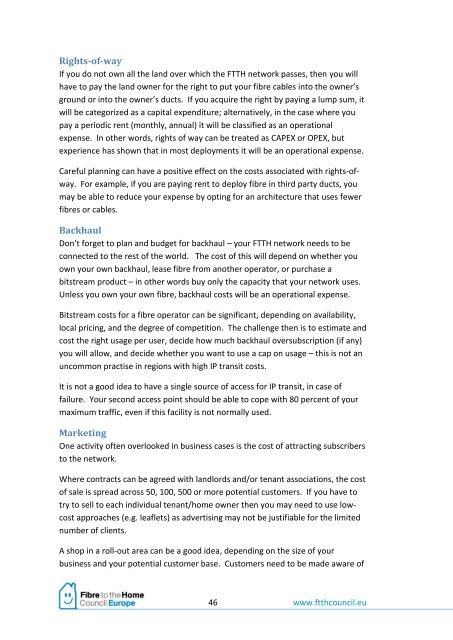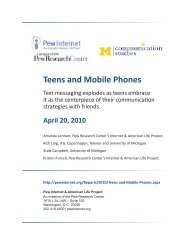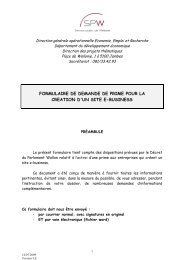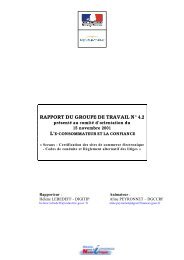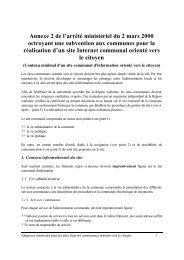Create successful ePaper yourself
Turn your PDF publications into a flip-book with our unique Google optimized e-Paper software.
Rights-of-way<br />
If you do not own all the land over which the <strong>FTTH</strong> network passes, then you will<br />
have to pay the land owner for the right to put your fibre cables into the owner’s<br />
ground or into the owner’s ducts. If you acquire the right by paying a lump sum, it<br />
will <strong>be</strong> categorized as a capital expenditure; alternatively, in the case where you<br />
pay a periodic rent (monthly, annual) it will <strong>be</strong> classified as an operational<br />
expense. In other words, rights of way can <strong>be</strong> treated as CAPEX or OPEX, but<br />
experience has shown that in most deployments it will <strong>be</strong> an operational expense.<br />
Careful planning can have a positive effect on the costs associated with rights-ofway.<br />
For example, if you are paying rent to deploy fibre in third party ducts, you<br />
may <strong>be</strong> able to reduce your expense by opting for an architecture that uses fewer<br />
fibres or cables.<br />
Backhaul<br />
Don’t forget to plan and budget for backhaul – your <strong>FTTH</strong> network needs to <strong>be</strong><br />
connected to the rest of the world. The cost of this will depend on whether you<br />
own your own backhaul, lease fibre from another operator, or purchase a<br />
bitstream product – in other words buy only the capacity that your network uses.<br />
Unless you own your own fibre, backhaul costs will <strong>be</strong> an operational expense.<br />
Bitstream costs for a fibre operator can <strong>be</strong> significant, depending on availability,<br />
local pricing, and the degree of competition. The challenge then is to estimate and<br />
cost the right usage per user, decide how much backhaul oversubscription (if any)<br />
you will allow, and decide whether you want to use a cap on usage – this is not an<br />
uncommon practise in regions with high IP transit costs.<br />
It is not a good idea to have a single source of access for IP transit, in case of<br />
failure. Your second access point should <strong>be</strong> able to cope with 80 percent of your<br />
maximum traffic, even if this facility is not normally used.<br />
Marketing<br />
One activity often overlooked in business cases is the cost of attracting subscri<strong>be</strong>rs<br />
to the network.<br />
Where contracts can <strong>be</strong> agreed with landlords and/or tenant associations, the cost<br />
of sale is spread across 50, 100, 500 or more potential customers. If you have to<br />
try to sell to each individual tenant/home owner then you may need to use lowcost<br />
approaches (e.g. leaflets) as advertising may not <strong>be</strong> justifiable for the limited<br />
num<strong>be</strong>r of clients.<br />
A shop in a roll-out area can <strong>be</strong> a good idea, depending on the size of your<br />
business and your potential customer base. Customers need to <strong>be</strong> made aware of<br />
46 www.ftthcouncil.eu


